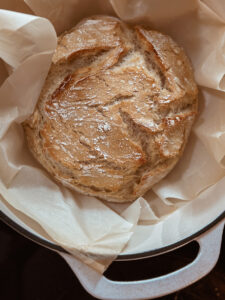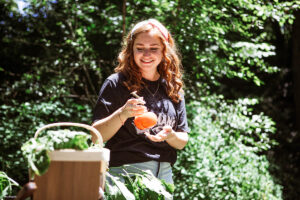
Recently I had the privilege of visiting Anna*, a longtime friend of my grandmother’s. Penpals for decades although they live just a few miles apart, they met in an apple orchard and immediately bonded over their shared frugal ways.
Anna is a 70-ish widow who belongs to one of the strictest orders of the Amish, so I expected her house to be very bare, almost austere. But I was wrong. Like Anna, her house was a delight in the purest and most innocent sense. In fact, Anna’s house taught me…
1. Bare is not barren. Most Amish groups live extremely simply, and their homes reflect their religious beliefs. While no artwork, photographs or mirrors bedecked the walls, the home still radiated Anna’s charming personality and obvious love of people.
The sitting room where we visited was oriented toward conversation and rapport. Wooden rocking chairs with padded cushions flanked the wood stove, which was blazing away. A simple desk sat beneath a window overlooking the driveway. I could easily imagine Anna seated there, penning letters to friends (including my grandmother) as she watched her grandchildren play and eyed the driveway for visitors.
As we sat together, I couldn’t help but think of my own living room, where the plush furniture blankly faced the television. (This has since been remedied. The couches, and their occupants, now face each other.)
Lesson: Rearrange and declutter to uncover what matters. Display one or two treasures instead of fifteen. Simplify and really notice your home, not just the stuff in it.

2. Quiet is good. Since the Amish do not use electricity, there were no whirring appliances or computers, droning radios or buzzing fluorescent light bulbs in Anna’s home (if you’re really quiet in your house, I’ll bet you can hear them). Besides our chatting, there was only the pleasant ticking of a wall clock and occasional pings from the stove. In fact, even in the midst of our almost constant conversation I could “hear” the silence … and it was strangely comforting.
Lesson: Unplug and listen. Learn to turn things off when they’re not in use. Sit down with a book in the silence of the evening (or early morning), and relish the absence of that constant background whir.

3. Real aromatherapy is the best. On the sunny day we visited, Anna’s kitchen was fairly bursting with apples. They covered almost every surface, the fragrant slices laid out on old window screens to dry. Anna explained that her children and grandchildren (several of whom lived next door) like to make fry pies from the dried apples. In any case, the apple-y aroma – mixed with a hefty dose of wood smoke and hints of kerosene – made Anna’s house smell fantastic. The power of scent is well-known. The funny thing was, Anna didn’t even need to buy or do anything extra to enjoy those scents. She was just going about her day.
Lesson: Create “real” scents in your home. Bake bread. Make applesauce, or lemon pudding, or a stew, or a batch of scented soap, or anything else that smells good to you. Hang sheets out to dry and enjoy that “fresh air” scent indoors. (Plus, you’ll be getting some great things done in the process!)
In other words, appreciate the extraordinary in the ordinary. That’s by far the biggest lesson I learned from my visit to Anna’s house.
*Name changed to protect privacy. This post was first published in April 2014.


































Indeed!
I think your farm house and property are beautiful. I too like the simple ways of living. I find it hard with all the good old furniture and things I have inherited. I have store many of them to pass on to my grandchildren when they need them. Thank you for sharing your visit. It encourages me to do some more simple things that make a big difference in making my home even better.